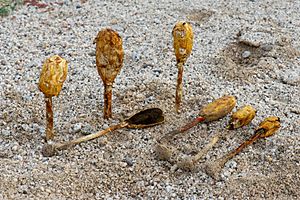Desert shaggy mane facts for kids
Quick facts for kids Desert shaggy mane |
|
|---|---|
 |
|
| P. pistillaris | |
| Scientific classification | |
| Kingdom: | |
| Division: | |
| Class: | |
| Order: |
Agaricales
|
| Family: |
Agaricaceae
|
| Genus: |
Podaxis
|
| Species: |
P. pistillaris
|
| Binomial name | |
| Podaxis pistillaris |
|
| Podaxis pistillaris | |
|---|---|
| Mycological characteristics | |
| gills on hymenium | |
| cap is conical | |
| hymenium is seceding | |
| stipe has a ring | |
| spore print is buff to reddish-brown | |
| ecology is saprotrophic | |
| edibility: edible | |
Podaxis pistillaris is a unique type of fungus that is related to puffballs. It is often called the desert shaggy mane because it looks a bit like another mushroom called the shaggy mane (Coprinus comatus). However, these two fungi are not closely related.
This fungus can grow up to 15 centimeters (about 6 inches) tall. It has a hard, woody stem. The large cap of the fungus protects the dark, spore-producing parts inside. When the fungus is ready, the cap splits open and usually falls off. This allows the tiny spores to be carried away by the wind. You might see many of these fungi appear after heavy rains.
Podaxis pistillaris loves to grow in deserts and semi-deserts. You can find it in places like Australia and other countries. In South Africa, it often grows on termite mounds. In the Hawaiian Islands, it is common along roadsides and in areas where the land has been disturbed, especially in dry parts of the islands.
Spore Facts
The spores of Podaxis pistillaris are usually broadly oval or almost round. They are smooth and can be yellow to a deep reddish-brown color. Each spore has a double wall and a small opening at the top. These spores are how the fungus spreads and grows in new places.
How it's Organized
Even though Podaxis pistillaris looks like a "stalked puffball," it is actually a type of agaric. Agarics are usually mushrooms with gills, but this fungus has changed over time. It has lost the typical gill structure and cannot shoot out its spores like some other fungi. Despite its appearance, it is more closely related to the shaggy mane mushroom than to true puffballs.
Uses of the Fungus
In Australia, many desert tribes used Podaxis pistillaris for different purposes. They would use it to darken the white hair on older men's whiskers. It was also used for body painting. Because this fungus grows widely in dry areas of Australia, it was likely used by many Aboriginal people. There are also stories that it was used to keep flies away.
Besides the common Podaxis pistillaris that grows on the ground, there is another type in Australia called Podaxis beringamensis. This one is found on termite mounds. It is believed that both types were used by the local people.
This fungus is not poisonous, but people do not commonly eat it. Like many "puffballs," Podaxis pistillaris can be used to dye fabrics. It can create colors ranging from tan to reddish. To get these colors, it needs an alkaline (basic) substance. Many people who dye at home use ammonia for this. In older times, people sometimes used urine.
See also
 In Spanish: Podaxis pistillaris para niños
In Spanish: Podaxis pistillaris para niños

